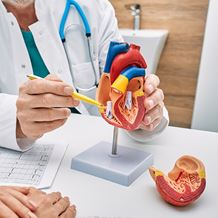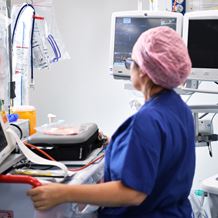
- Home
- Services
- Cardiac Services
- Procedures and Treatments
- Atrial Septal Defect Closures
What is atrial septal defect closure?
Atrial septal defect closure is a medical procedure to repair an abnormal opening in the wall of the upper heart chambers. This is known as an atrial septal defect (ASD). If this structural defect has not naturally closed up within a certain timeframe, your doctor may recommend surgery to prevent future health complications. ASD closure can be performed using minimally invasive techniques or as open surgery depending on the size and location of the hole, with a special closing device or stitches to seal the hole shut.
What does it do?
Atrial septal defect closure is a surgical treatment to repair a structural heart problem, and to help prevent future health complications. If the hole in the heart wall is small, it may not cause any symptoms or problems. If the ASD is large enough so that blood can leak in between the upper heart chambers, this can put additional pressure on the heart and lungs and cause increased health complications. Atrial septal defect closure surgery reduces the risk of symptoms and complications that are commonly associated with a hole in the heart such as arrythmia, stroke, pulmonary hypertension and heart failure.
How does it work?
Atrial septal defects are present from birth and are a structural problem that typically occurs during development in the womb. Whilst they may often close up shortly after birth, in some cases patients are born with a large hole that does not close properly. This can lead to blood leaking into the wrong chamber and associated health complications. Once the ASD has been diagnosed using various tests such as an echocardiogram, chest X-ray, ECG (electrocardiogram), and CT scanning, your doctor may recommend surgical closure. A mesh patch or closure device is passed through to the heart using a catheter, or applied through open heart surgery. Heart tissue then naturally grows around the hole which permanently seals it closed as it becomes a natural part of the heart wall.
Why is it performed?
ASD is a congenital heart defect that does not often cause noticeable symptoms. The severity of the condition will depend on the size of the hole, and how much blood is able to leak in between the chambers and place pressure on the heart and lungs. If the hole is not likely to heal by itself and is large enough to cause symptoms and complications, surgery may be recommended to mitigate further damage to the heart and lungs. Symptoms generally include:
- Heart murmur
- Fatigue
- Irregular heart rhythm (arrythmia)
- breathlessness
Procedure
There are several techniques for ASD closure. It is usually performed using minimally invasive techniques or as open-heart surgery. Your doctor will talk to you about the most appropriate procedure for your condition.
Non-invasive (percutaneous):
- A local anaesthetic is applied to the groin area
- A special catheter is inserted into the leg vein, carrying the closure device
- The catheter is guided up towards the location of the hole
- Once in position, the device is released and the hole is plugged
Surgical approach:
- A general anaesthetic is given
- You are attached to a heart-lung bypass machine which controls your heartbeat
- An incision is made in your chest
- The hole is repaired using a special patch
- The wound is closed and dressed
Recovery
After the procedure, your progress is monitored and your doctor will take some images of your heart to ensure the hole has closed up successfully. Your medical team will talk to you about what to expect during your recovery, and any medication required. Follow-up appointments are typically necessary to ensure the success of the surgical procedure.
What's next?
If you have been experiencing heart-related symptoms, book an appointment with our cardiac services specialist today.
Our specialists in Cardiac Services
View all specialists





